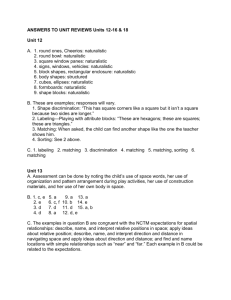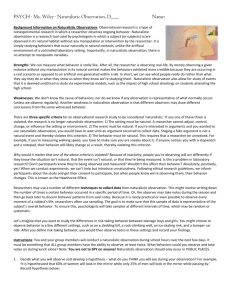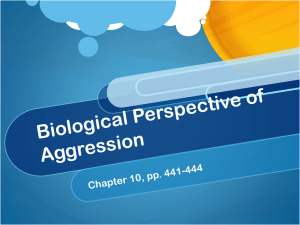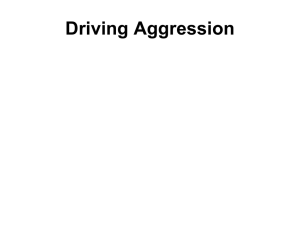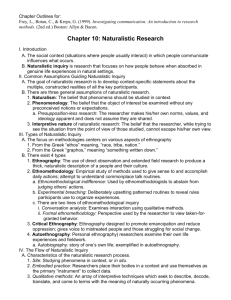Observational Method and Aggression in Hockey Players
advertisement
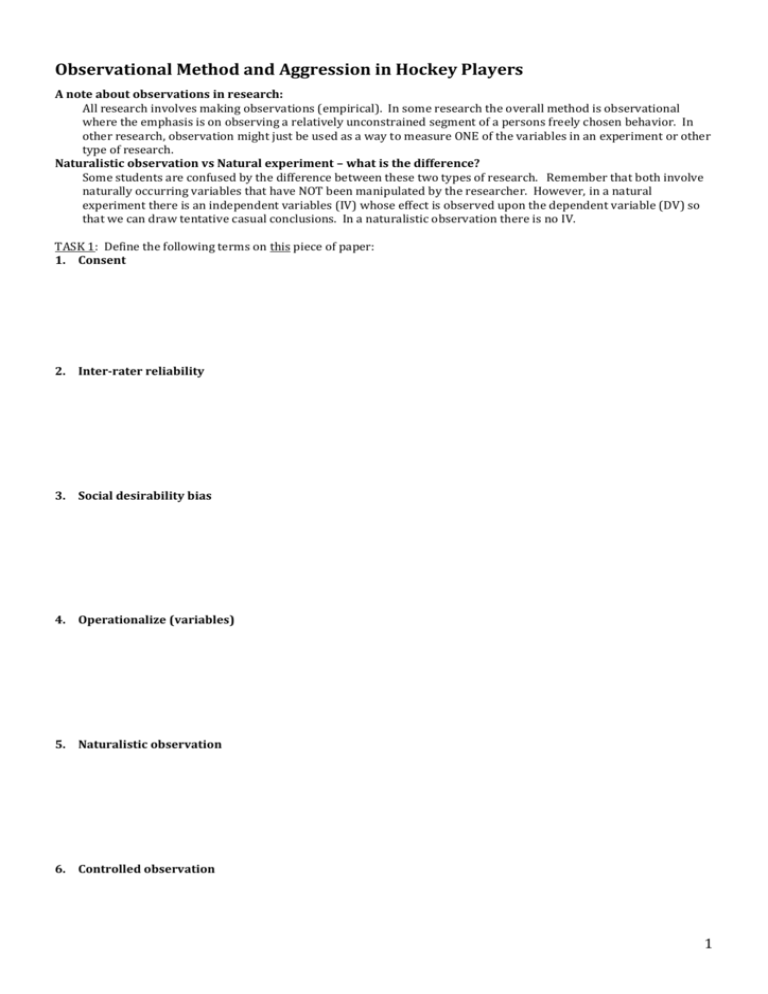
Observational Method and Aggression in Hockey Players A note about observations in research: All research involves making observations (empirical). In some research the overall method is observational where the emphasis is on observing a relatively unconstrained segment of a persons freely chosen behavior. In other research, observation might just be used as a way to measure ONE of the variables in an experiment or other type of research. Naturalistic observation vs Natural experiment – what is the difference? Some students are confused by the difference between these two types of research. Remember that both involve naturally occurring variables that have NOT been manipulated by the researcher. However, in a natural experiment there is an independent variables (IV) whose effect is observed upon the dependent variable (DV) so that we can draw tentative casual conclusions. In a naturalistic observation there is no IV. TASK 1: Define the following terms on this piece of paper: 1. Consent 2. Inter-rater reliability 3. Social desirability bias 4. Operationalize (variables) 5. Naturalistic observation 6. Controlled observation 1 7. Structured observations (systematic observations) 8. Unstructured observations 9. Covert observation 10. Overt observation 11. Coding (as related to the observational method) 12. “A priori” Coding 12. “Emergent” Coding 2 TASK 2: Read the following example of a naturalistic observation and explain why it could be considered a naturalistic observation. Do little boys criticize each other if they behave like girls? Do little boys “reward” each other for sex “appropriate” play? Is the same for little girls? One study observed boys and girls aged between three and five years during their free-play periods at nursery school. The researchers classified activities as male, female or neutral and recorded how playmates responded. Praise and imitation constituted some of the positive responses. Criticism and stopping play were some of the negative responses. The researchers found that children generally reinforced peers for sex appropriate play and were quick to criticize sex-inappropriate play (Lamb and Roopnarine, 1979). Q: Why is this a naturalistic observation? Because….(explain) TASK 3: Read the following example and answer the question that follows: The same research as described above could have been conducted by controlling some of the variables. For example, the researchers might have set up a special playroom in their lab with certain types of toys available (male, female, and neutral). Q: Would a one-way mirror helped to increase the validity of the results? Why? Would this have been ethical? Briefly explain your answers using relevant terms. TASK 4 – read the following example of an experiment that used observation techniques (this is common, particularly in SLOA). Answer the question that follows. In the “Bobo doll study” by Bandura et al (1961) the children’s aggressiveness was OBSERVED in the experiment to see if those exposed to the aggressive model behaved more aggressively. A the end of the experiment each child was taken to a room that contained some aggressive toys (e.g. a mallet and a dart gun), some non-aggressive toys (e.g. dolls and farm animals) and a three foot Bobo Doll. The experimenter stayed with the child while he or she played for 20 minutes, during which time the child was observed through a one-way mirror. The observers recorded what the child was doing every five seconds, for example noting: Imitation of physical aggression – any specific acts that were imitated. Imitative verbal aggression – any phrases that were imitated such as the word “Pow!” Imitative non-aggressive verbal responses - such as “He keeps coming back for more”. Non-imitative physical and verbal aggression – aggressive acts directed at toys other than the Bobo doll. For example, saying things not said by the model, or that were not demonstrated by the model playing with the gun. Q: Did the experimenter use a structured or unstructured observational technique in their experiment? Explain, using specific evidence from the example above. TASK 5 – Unstructured observation activity: 1. Work with a partner and take turns to observe each other. One of you will per person “A” and the other person “B”. 2. Person A should have a difficult task to do (answering questions from task 6 and/or 7 or outlining a learning outcome from this unit will be appropriate). Person B observes person A doing this for 5 minutes. IMPORTANT: No communication should occur between person A and person B during this time. 3 3. 4. 5. Person B should write down any aspect of their partner’s behavior they observe. Then, Person A should observe person B doing a boring task such as copying (I am giving you permission) the answers that person A when they were completing the difficult task. Again, no communication should occur between the two of you. QUESTIONS (when you are finished) a. Draw some conclusions from the observations (both sets). Write these down. b. Was it easy or difficult to record your partner’s behaviors? Describe/explain your reasons. c. How could you improve the record keeping or the observation process? TASK 6 – Fill in the boxes: Environment or behavior Method of data collection Structure No Structure Structure No Structure Correctly fill in the boxes with the following information: Naturalistic observation with structured observational techniques Controlled observation with unstructured observational techniques Naturalistic observation with unstructured techniques Controlled observation with structured observational techniques Once you finish, please move to the next task if you are being observed… 4 Directions: Please read the following study and then answer the questions that follow in the space provided. All questions should be answered in complete sentences. The aim of following study was to see if there are any trends in aggressive behavior during hockey tournaments. Participants were 79 male varsity hockey players. Coaches were approached and informed of the study. Once permission was granted the teams were approached and asked for consent. The consent process occurred roughly 3 weeks before the tournament, in an attempt to minimize any social desirability biases. On game day, two cameras were placed on opposite sides of the rink. The cameras were placed at center ice, in order to provide the most detailed picture of the entire playing surface. Camera operators were instructed to capture as many of the players as possible at any one time, while always maintaining a relatively clear picture (i.e., viewing the players’ numbers). Three games were observed. The competitive tapes were coded by two independent observers using an operationalized check-list, with a high interrater reliability. The “intent to harm” was the defining characteristic of aggressive behavior. Fourteen behaviors were labeled as “aggression”, including: cross-checking, fighting, charging, head-butting, kneeing, spearing, high sticking, and elbowing. A total of 74 aggressive behaviors were coded from the three games under investigation. Of the 74 behaviors coded by the two independent observers, only 14 received actual on-ice penalization. With respect to overall performance, winning, losing, and tied teams committed relatively equal numbers of aggressive acts. Also, there was no significant difference observed between players occupying different positions. Both offensive and defensive players committed relatively the same number of aggressive acts. Gee, C. J., & Sullivan, P. J. (2006). Using a direct observation approach to study aggressive behavior in ice hockey: Some preliminary findings. Athletic Insight, 8. Questions - Please answer all of the following questions. 1. The summary above says that “The consent process occurred roughly three weeks before the tournament, in an attempt to minimize any social desirability biases.” What is meant by “to minimize any social desirability biases?” (2 marks) 2. The summary above says that “ The competitive tapes were coded by two independent observers using an operationalized check-list, with a high inter-rater reliability.” What is meant by “inter-rater reliability?” (2 marks) 3. Classify the type of observation this was. Was it naturalistic or controlled, covert or overt observation? Participant or non-participant observation? A combination of these? Then, explain one strength and one limitation of using this type of observation? (6 marks) 5 4. Which type of coding was used – a priori or emergent? Explain one strength and one limitation of using this coding method? (5 marks) 5. Identify one concern you have about the way that this study was carried out. (3 marks) 6

